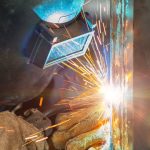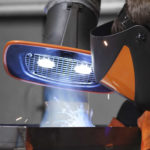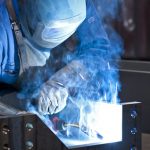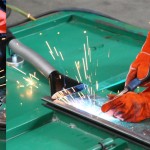MAG-welding: common, despite high emissions of welding fumes
Different sizes of arcs can be adjusted for MAG welding depending on the material, sheet metal thickness or wall thickness, which makes this type of welding a must for the everyday work of welders. Unalloyed and alloyed steels are welded preferably with active gases, e.g. carbon dioxide. More than half of all welding work belongs to the processing group which is divided in metal active welding with carbon dioxide (MAGC) and metal active welding with mixed gas (MAGM). MAG welding influences the exposure of welders to hazardous substances in two ways:
“Active” in MAG means that the gases change
Firstly, the word “active” says it all: The gases used during the welding process change in their chemical  composition. The inert gas carbon dioxide becomes e.g. carbon monoxide during MAGC welding. Furthermore, the arc also has an effect on the creation of hazardous substances. MAG welding is an arc welding process: An endless wire electrode melts underneath an inert gas cover which protects against the atmosphere.
composition. The inert gas carbon dioxide becomes e.g. carbon monoxide during MAGC welding. Furthermore, the arc also has an effect on the creation of hazardous substances. MAG welding is an arc welding process: An endless wire electrode melts underneath an inert gas cover which protects against the atmosphere.
Mainly, you have to expect a strong development of welding fumes when working with active gas processes – the same approximate quantity as for arc welding with covered rod electrodes. In addition to welding fumes, carbon monoxide (CO) is a leading component when MAGC-welding unalloyed and low alloy steel. It is created by the thermal decomposition of the carbon dioxide which is used as inert gas. The welding fumes mainly consist of iron oxides.
Welding fumes consist mainly of iron oxides
During MAGM-welding of unalloyed or low alloy steel, a CO formation can be expected if the mixed gas contains carbon dioxide. The welding fumes consist of iron oxides in the same way as if MAGC-welding. Furthermore, the MAGM-welding is also suited for processing chrome-nickel steel. Nickel oxide is here the main component. When MAG-welding with cored wire electrodes, larger quantities of welding fumes develop as when work is done with solid wire electrodes. The harmful emissions rise with increasing intensity of the arc as well as increasing wire feed speed.
As measured by the emission rates, all MAG processes have a high to very high risk potential for the welders’ health. Whilst MAG-welding with solid wire electrode is at least risky, experts consider e.g. the risks of MAG-welding with cored wire electrodes to be even higher.
Toxic gases have additional risks in addition to welding fumes
Gaseous substances also play a role in addition to the risk of welding fumes exposure. High concentration of carbon monoxide e.g. can block the oxygen transport in the body. The consequences are not only lack of oxygen in the tissue, dizziness or headaches: significant exposure can even cause cardiac arrest.
Particulate substances have to be considered during risk assessment. Toxic substances such as manganese oxide, which is created when MAGM-welding of chrome-nickel steel with solid wire, irritate the respiratory tract in high concentrations and may damage the nervous system. Nickel oxide can cause cancer when used in the same process – just as much when using chrome VI compounds for MAGM-welding of chrome-nickel steel with cored wire electrode.
Despite the popularity of MAG-welding, overall it is important that welders protect themselves effectively against the effects of these hazardous substances. An adequate extraction plant and filter systems are ideal to prevent the substances to even get into the respiratory track or ambient air.





